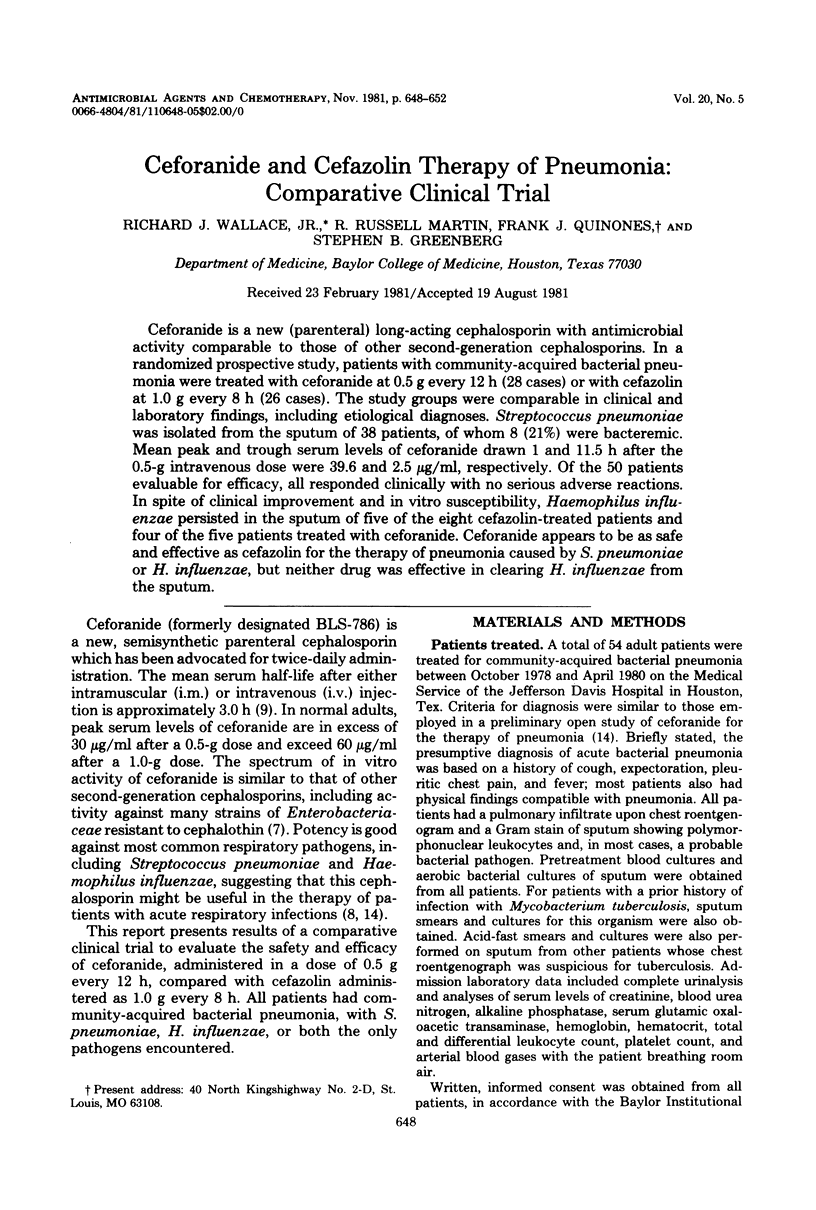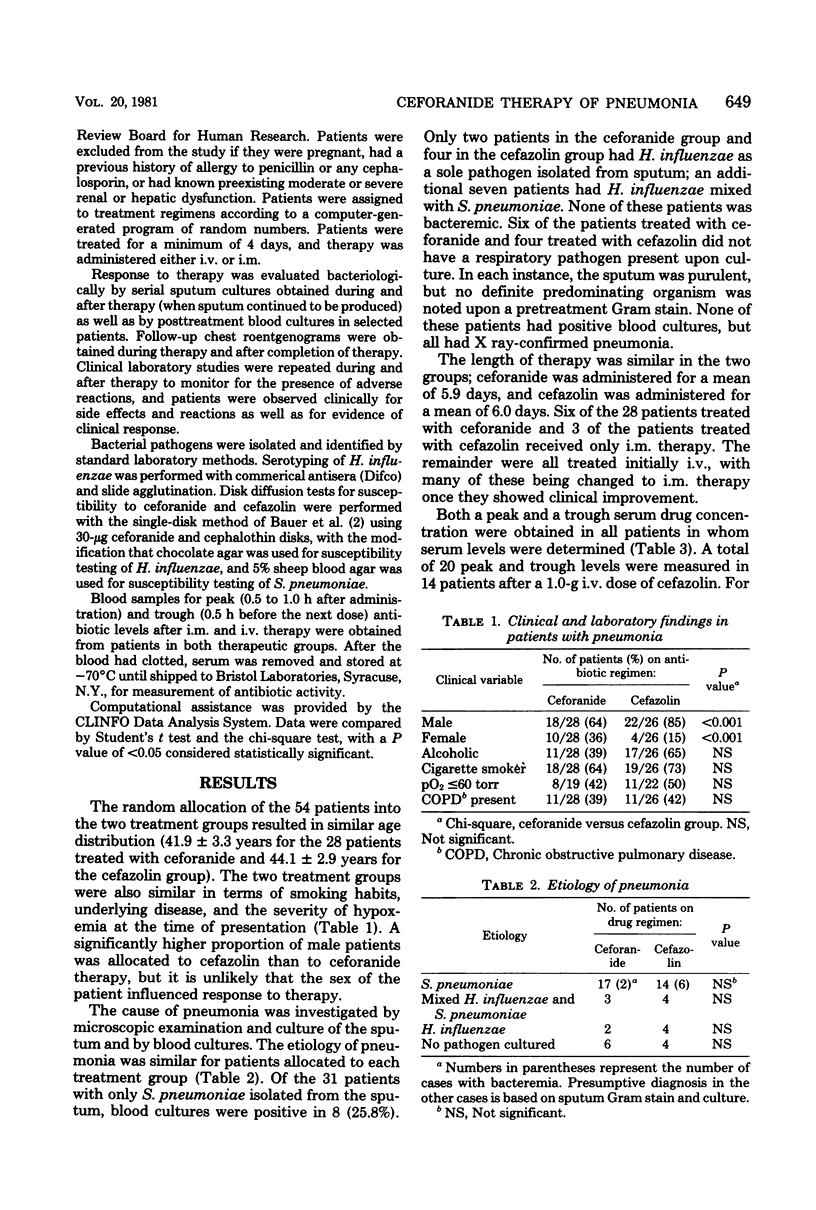Abstract
Ceforanide is a new (parenteral) long-acting cephalosporin with antimicrobial activity comparable to those of other second-generation cephalosporins. In a randomized prospective study, patients with community-acquired bacterial pneumonia were treated with ceforanide at 0.5 g every 12 h (28 cases) or with cefazolin at 1.0 g every 8 h (26 cases). The study groups were comparable in clinical and laboratory findings, including etiological diagnosis. Streptococcus pneumoniae was isolated from the sputum of 38 patients, of whom 8 (21%) were bacteremic. Mean peak and trough serum levels of ceforanide drawn 1 and 11.5 h after the 0.5-g intravenous dose were 39.6 and 2.5 microgram/ml, respectively. Of the 50 patients evaluable for efficacy, all responded clinically with no serious adverse reactions. In spite of clinical improvement and in vitro susceptibility, Haemophilus influenzae persisted in the sputum of five of the eight cefazolin-treated patients and four of the five patients treated with ceforanide. Ceforanide appears to be as safe and effective as cefazolin for the therapy of pneumonia caused by S. pneumoniae or H. influenzae, but neither drug was effective in clearing H. influenzae from the sputum.
Full text
PDF




Selected References
These references are in PubMed. This may not be the complete list of references from this article.
- AUSTRIAN R., GOLD J. PNEUMOCOCCAL BACTEREMIA WITH ESPECIAL REFERENCE TO BACTEREMIC PNEUMOCOCCAL PNEUMONIA. Ann Intern Med. 1964 May;60:759–776. doi: 10.7326/0003-4819-60-5-759. [DOI] [PubMed] [Google Scholar]
- Bauer A. W., Kirby W. M., Sherris J. C., Turck M. Antibiotic susceptibility testing by a standardized single disk method. Am J Clin Pathol. 1966 Apr;45(4):493–496. [PubMed] [Google Scholar]
- Delgado D. G., Brau C. J., Cobbs C. G., Dismukes W. E. Clinical and laboratory evaluation of cefamandole in the therapy of Haemophilus spp. Bronchopulmonary infections. Antimicrob Agents Chemother. 1979 Jun;15(6):807–812. doi: 10.1128/aac.15.6.807. [DOI] [PMC free article] [PubMed] [Google Scholar]
- Finland M. Pneumonia and pneumococcal infections, with special reference to pneumococcal pneumonia. The 1979 J. Burns Amberson lecture. Am Rev Respir Dis. 1979 Sep;120(3):481–502. doi: 10.1164/arrd.1979.120.3.481. [DOI] [PubMed] [Google Scholar]
- Hansman D., Glasgow H., Sturt J., Devitt L., Douglas R. Increased resistance to penicillin of pneumococci isolated from man. N Engl J Med. 1971 Jan 28;284(4):175–177. doi: 10.1056/NEJM197101282840403. [DOI] [PubMed] [Google Scholar]
- Jacobs M. R., Koornhof H. J., Robins-Browne R. M., Stevenson C. M., Vermaak Z. A., Freiman I., Miller G. B., Witcomb M. A., Isaäcson M., Ward J. I. Emergence of multiply resistant pneumococci. N Engl J Med. 1978 Oct 5;299(14):735–740. doi: 10.1056/NEJM197810052991402. [DOI] [PubMed] [Google Scholar]
- Jones R. N., Fuchs P. C., Gavan T. L., Gerlach E. H., Barry A., Thornsberry C. BL-S786, a new parenteral cephalosporin. I. A collaborative in vitro susceptibility comparison to cephalothin against 5,762 clinical bacterial isolates. J Antibiot (Tokyo) 1977 Jul;30(7):576–582. doi: 10.7164/antibiotics.30.576. [DOI] [PubMed] [Google Scholar]
- Jones R. N., Thornsberry C., Barry A. L., Fuchs P. C., Gavin T. L., Gerlach E. H. BL-S786, a new parenteral cephalosporin. II. In vitro antimicrobial activity comparison with six related cephalosporins. J Antibiot (Tokyo) 1977 Jul;30(7):583–592. doi: 10.7164/antibiotics.30.583. [DOI] [PubMed] [Google Scholar]
- Lee F. H., Pfeffer M., Van Harken D. R., Smyth R. D., Hottendorf G. H. Comparative pharmacokinetics of ceforanide (BL-S786R) and cefazolin in laboratory animals and humans. Antimicrob Agents Chemother. 1980 Feb;17(2):188–192. doi: 10.1128/aac.17.2.188. [DOI] [PMC free article] [PubMed] [Google Scholar]
- Mangi R. J., Kundargi R. S., Quintiliani R., Andriole V. T. Development of meningitis during cephalothin therapy. Ann Intern Med. 1973 Mar;78(3):347–351. doi: 10.7326/0003-4819-78-3-347. [DOI] [PubMed] [Google Scholar]
- Ng W. S., Anton P., Arnold K. Neisseria gonorrhoeae strains isolated in Hong Kong: in vitro susceptibility to 13 antibiotics. Antimicrob Agents Chemother. 1981 Jan;19(1):12–17. doi: 10.1128/aac.19.1.12. [DOI] [PMC free article] [PubMed] [Google Scholar]
- Petty B. G., Smith C. R., Wade J. C., Conrad G. L., Lipsky J. J., Ellner J. J., Lietman P. S. Double-blind comparison of cefamandole and penicillin in pneumococcal pneumonia. Antimicrob Agents Chemother. 1978 Jul;14(1):13–18. doi: 10.1128/aac.14.1.13. [DOI] [PMC free article] [PubMed] [Google Scholar]
- Quintiliani R., Nightingale C. H. Cefazolin. Ann Intern Med. 1978 Nov;89(5 Pt 1):650–656. doi: 10.7326/0003-4819-89-5-650. [DOI] [PubMed] [Google Scholar]
- Wallace R. J., Jr, Martin R. R., Greenberg S. B. Ceforanide (BL-S786) in the treatment of community-acquired bacterial pneumonia. Infection. 1979;7(4):176–179. doi: 10.1007/BF01640937. [DOI] [PubMed] [Google Scholar]
- Watanakunakorn C., Glotzbecker C. Comparative susceptibility of Haemophilus species to cefaclor, cefamandole, and five other cephalosporins and ampicillin, chloramphenicol, and tetracycline. Antimicrob Agents Chemother. 1979 Jun;15(6):836–838. doi: 10.1128/aac.15.6.836. [DOI] [PMC free article] [PubMed] [Google Scholar]
- Wong G. A., Pierce T. H., Goldstein E., Hoeprich P. D. Penetration of antimicrobial agents into bronchial secretions. Am J Med. 1975 Aug;59(2):219–223. doi: 10.1016/0002-9343(75)90356-3. [DOI] [PubMed] [Google Scholar]


